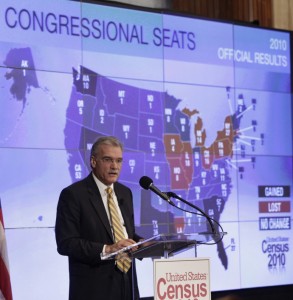
As the Census Bureau continues to release data from last year’s Census, more states and metropolitan areas are seeing proof of what they already know – the Hispanic population continues to fuel growth in many parts of this country.
The latest numbers to be released earlier this week showed that in Oklahoma the Hispanic population grew by 85%, and in Illinois Hispanics became the largest minority.
Hispanics now make up nearly 9 percent of Oklahoma’s population and 15.8 percent of Illinois’ population.
“The 2000 Census did a poor job of counting Hispanics,” David Castillo, executive director of the Greater Oklahoma City Hispanic Chamber of Commerce, said. “This time more education was done in the Hispanic community about the census and its importance.”
Hispanics have now replaced Native Americans as the largest minority in the state.
The growing Hispanic population is also making an impact on the economy. A study conducted by the Chamber revealed that the number of Hispanic-owned businesses in the state increased from 180 to 300 in just the last three years.
“People are starting to get it — we’re not invisible, and we have money to spend,” Jorge Hernandez, executive director of Capitol Hill Main Street program, said.
In Oklahoma City, only one Spanish radio station and one Spanish-language newspaper existed twenty years ago. Now there are four newspapers, three radio stations and four television stations catering to Hispanics in the area, according to Hernandez.
In Illinois, the big story to come out of the Census is the dwindling population of Chicago, but the Hispanic population experienced the exact opposite by increasing and replacing blacks as the largest minority in the state.
Over the past decade, the Hispanic population grew by 497,316 to 2.03 million while the black population dropped by 23,228 to 1.83 million. Overall, Chicago lost about 200,418 residents.
Sylvia Puente, executive director of the Latino Policy Forum, a public policy and advocacy organization based in Chicago says Hispanics should see an increase in more government investment in education, housing and education and a renewed focus on immigration issues.
“If we aren’t investing in the Latino community,” she says, “it’s no longer going to impact just the Latino community. It’s going to impact … the economic viability of the region and the state.”
Chicago is likely to remain the country’s third largest city, but the state will lose 1 of its 19 congressional seats.
The next states expected to receive their data from the Census include Texas and South Dakota.

Very informative post. To clarify, while Illinois’ Latino community has grown by more than 32% in the state over the past decade, making it the second-largest ethnic group in Illinois, the same does not hold true for the city of Chicago. Chicago’s African American population is still larger than its Latino population. Recent Census data shows that Chicago’s Latino population growth was just 3.3%, though some say this low statistic is the result of an undercount. Mark Brown’s recent column from the Chicago Sun-Times provides perspective: http://www.suntimes.com/news/brown/3859871-452/i-hope-census-got-right-when-they-counted-hispanics.html?print=true